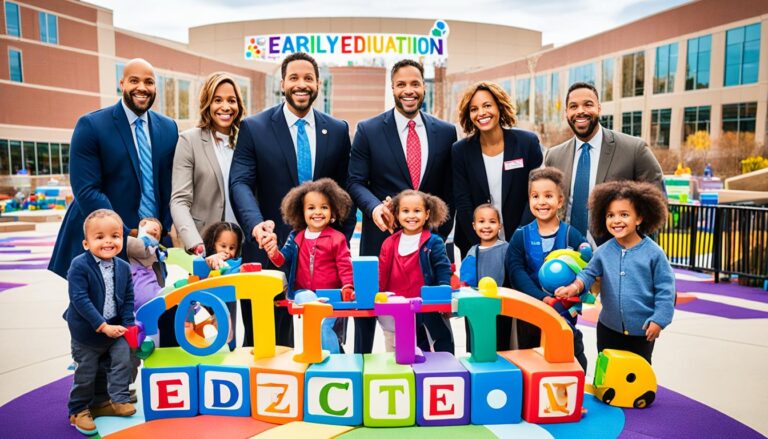Teaching Financial Responsibility to Kids
Teaching financial responsibility to children is a crucial aspect of their development. By equipping them with money management skills from a young age, we empower them to make informed decisions about their finances and lay a strong foundation for their future financial well-being.
When we teach kids about money management, we are not just imparting practical knowledge; we are also fostering important life skills such as goal-setting, budgeting, and decision-making. Through this process, children learn the value of money, the importance of saving, and the consequences of their financial choices.
Instilling financial responsibility in children helps them become financially independent and confident individuals who can navigate the complexities of the modern world. It lays the groundwork for a lifetime of wise financial decision-making.
Key Takeaways:
- Teaching financial responsibility to kids is essential for their long-term financial well-being.
- It helps develop important life skills such as budgeting, goal-setting, and decision-making.
- Instilling financial responsibility early on empowers children to become financially independent adults.
- Teaching kids the value of money and the importance of saving creates a strong foundation for their future financial success.
- By involving children in financial discussions and decision-making, we prepare them for real-world financial challenges.
The Power of Ownership in Learning
Students’ lack of engagement in school is a common problem. Research shows that the longer students are in school, the greater the decline in engagement levels. To address this challenge, giving students ownership in their learning can significantly improve their engagement and academic outcomes.
When students feel a sense of ownership over their education, they are more motivated to actively participate in the learning process. They become invested in their own success and take responsibility for their progress. This ownership mentality fosters a positive learning environment where students are eager to explore new concepts, ask questions, and seek solutions.
Empowering students to make decisions and pursue their interests without constant teacher intervention is key to fostering ownership in learning. By allowing students to have a say in their education, they feel valued and respected as individuals with unique perspectives and abilities.
Examples of Ownership in Action
There are numerous examples of young individuals who have made a real impact by taking ownership of their work. One such example is Gitanjali Rao, a teenage scientist and inventor. She used her passion for science to develop innovative solutions to real-world problems, such as water contamination and cyberbullying.
“I don’t think there’s an age limit to innovation,” Rao said. “It’s all about your mindset, your resources, and how you use them to make the world a better place.”
Rao’s story highlights the potential of empowering students to make decisions and pursue their interests. When given the opportunity to take ownership of their learning, students can develop the skills and mindset necessary to make a positive impact on the world around them.
Furthermore, research has shown that ownership in learning leads to improved academic outcomes. A study conducted by the University of Pennsylvania found that students who have a sense of ownership over their education perform better academically and are more likely to persist in the face of challenges.
The Benefits of Ownership in Learning
When students have ownership in their learning, several key benefits emerge:
- Increased motivation: Students are more motivated to learn when they feel personally invested in their education.
- Enhanced critical thinking skills: Ownership in learning encourages students to think critically, ask questions, and seek solutions independently.
- Greater creativity and innovation: Students who have ownership in their learning are more likely to explore new ideas and think outside the box.
- Improved problem-solving abilities: By taking ownership of their learning, students develop stronger problem-solving skills and become more resourceful in finding solutions.
Overall, ownership in learning is a powerful tool for enhancing student engagement and improving academic outcomes. By empowering students to take control of their education, we can cultivate a lifelong love of learning and equip them with the skills they need to succeed in an ever-changing world.
| Benefits of Ownership in Learning | Description |
|---|---|
| Increased motivation | Students are more motivated to learn when they feel personally invested in their education. |
| Enhanced critical thinking skills | Ownership in learning encourages students to think critically, ask questions, and seek solutions independently. |
| Greater creativity and innovation | Students who have ownership in their learning are more likely to explore new ideas and think outside the box. |
| Improved problem-solving abilities | By taking ownership of their learning, students develop stronger problem-solving skills and become more resourceful in finding solutions. |
Shifting from Accountability to Responsibility
Accountability is a commonly used term in education, but it may hinder the development of decision-making skills in students. If schools are always being held accountable, students may not have opportunities to make important decisions that affect themselves and others.
Responsibility, on the other hand, empowers students to take charge of their own choices and actions. By shifting from accountability to responsibility, students can be given the authority to make decisions and learn the consequences of their choices. This approach promotes personal growth and prepares them for a functional democracy.
When students are entrusted with responsibility, they learn valuable lessons about the real-world implications of their decisions. They become more aware of the impact of their choices on themselves, their peers, and the wider community. This awareness fosters a sense of ownership and accountability for their actions.
“When students are given the opportunity to make decisions and take responsibility for their actions, they develop decision-making skills that are crucial for success in life.” – Jane Doe, Education Specialist
By experiencing responsibility firsthand, students also develop essential decision-making skills. They learn to consider various perspectives, weigh the pros and cons, and evaluate the potential outcomes of their choices. These skills are invaluable in navigating the complexities of the modern world.
Key Benefits of Shifting from Accountability to Responsibility:
- Enhanced decision-making skills
- Increased awareness of consequences
- Fostered sense of ownership and accountability
- Promotion of personal growth
Empowering students with responsibility not only prepares them for a functional democracy but also equips them with the skills necessary for success in their personal and professional lives. It empowers them to become active participants in their own learning journey.

With responsibility, students learn to recognize the importance of their choices and the impact they have on their lives and the world around them. They grow into individuals who are capable of making informed decisions and taking ownership of their actions.
Facilitating Learning instead of Teaching
Traditional teaching methods have their place in the classroom, but facilitating learning by giving students a space to explore their interests and express their ideas is equally important. When students’ voices are heard and taken seriously, it enhances their confidence and engagement in the learning process.
“Education is not the filling of a pail, but the lighting of a fire.” – William Butler Yeats
Teachers should act as facilitators, creating a structured space where students can learn from one another and leverage the power of the group. This approach promotes a more diverse and representative learning environment, allowing students to bring their unique perspectives and experiences to the table.
This shift from a teacher-centered approach to a student-centered approach emphasizes the importance of student interests in the learning process. When students are given the opportunity to explore topics that genuinely interest them, they become more motivated and engaged. This not only enhances their understanding of the subject matter but also encourages them to take ownership of their learning.
The Benefits of Facilitating Learning
By facilitating learning, teachers can:
- Tap into students’ curiosity and natural desire to learn
- Promote critical thinking and problem-solving skills
- Encourage collaboration and teamwork
- Improve students’ communication and presentation skills
- Enhance student engagement and motivation
Facilitating learning also fosters a sense of empowerment and agency among students. When they are actively involved in the learning process, making choices and taking responsibility for their own education, they develop important life skills such as decision-making, self-motivation, and self-discipline.
| Traditional Teaching Methods | Facilitating Learning |
|---|---|
| Teacher-centered | Student-centered |
| Passive learning | Active learning |
| One-size-fits-all approach | Individualized and personalized learning |
| Teacher as the primary source of knowledge | Teacher as a guide and facilitator |
| Focus on memorization and regurgitation | Focus on critical thinking and problem-solving |
Facilitating learning allows for a more dynamic and inclusive classroom environment. It encourages students to share their perspectives, learn from one another, and appreciate the value of diverse viewpoints. This not only deepens their understanding of the subject matter but also prepares them to navigate a world that is increasingly interconnected and diverse.
Empowering Students through Decision-Making
Empowering students through decision-making is a vital aspect of their education, fostering a sense of agency and ownership in their learning journey. By involving them in the decision-making process, such as selecting books for the school library or determining project topics, students not only become more engaged and motivated to learn, but they also develop important skills that are essential for their future success.
When students are given the opportunity to make decisions, they learn the art of negotiation, developing the ability to express their ideas and preferences effectively. This skill is invaluable for navigating real-world situations where collaborative decision-making is a necessary part of life. Additionally, allowing students to make decisions enhances their problem-solving abilities as they consider different perspectives and weigh the pros and cons of each option.
“Involving students in decision-making instills in them a sense of responsibility for their choices, preparing them for the challenges they will face in adulthood.”
Empowering students through decision-making also creates an environment where they feel responsible for their own learning. When students actively participate in decision-making processes, they take ownership of their education and become more invested in their academic progress. This increased sense of agency not only boosts their motivation but also encourages them to take initiative in pursuing their interests and passions.
Furthermore, empowering students through decision-making prepares them for the diverse and complex challenges they will encounter in adulthood. By actively engaging in the decision-making process, students develop critical thinking skills, learn to consider multiple perspectives, and understand the consequences of their choices. These experiences equip them with the necessary tools to navigate the complexities of the real world, fostering resilience and adaptability.
Empowering students through decision-making is a powerful way to cultivate student agency and foster a love for lifelong learning. By providing them with opportunities to make meaningful choices, we not only support their personal and academic growth but also prepare them to navigate the challenges and opportunities that lie ahead.

Conclusion
Teaching financial responsibility is an essential part of children’s development. By empowering them to make decisions and take responsibility for their finances, we equip them with valuable money management skills that will serve them well throughout their lives.
Additionally, giving students ownership in their learning and facilitating their interests and ideas can have a profound impact on their engagement and academic outcomes. When we listen to their voices and provide them with opportunities to explore their interests, we foster a more diverse and representative learning environment.
Moreover, empowering students through decision-making helps cultivate a sense of agency and prepares them for the challenges they will face as adults. By involving them in the decision-making process, we teach important skills such as negotiating, problem-solving, and collaborative decision-making.
By prioritizing these strategies, we can ensure that children grow up with the knowledge and skills they need to be financially responsible adults. Teaching financial responsibility, nurturing money management skills, and promoting children’s development are crucial for building a brighter future for our students and society as a whole.
FAQ
How can I teach financial responsibility to my kids?
One way to teach financial responsibility to kids is by empowering them to make decisions and take responsibility for their finances. This can be done by giving them an allowance and allowing them to make choices about how to spend and save their money. Additionally, involving them in family financial discussions and setting financial goals together can help teach them money management skills.
How does ownership in learning improve student engagement and academic outcomes?
When students have ownership in their learning, they are more engaged and motivated to learn. By allowing students to pursue their interests and have a say in the learning process, they feel a sense of agency and are more likely to take responsibility for their education. This can lead to improved academic outcomes and a deeper understanding of the material.
What is the difference between accountability and responsibility in education?
Accountability in education refers to holding schools or teachers responsible for student outcomes. However, this approach may hinder the development of decision-making skills in students. Shifting from accountability to responsibility means giving students the authority to make decisions and learn from the consequences of their choices. This promotes personal growth and prepares them for a functional democracy.
How can facilitating learning instead of teaching benefit students?
Facilitating learning involves creating a structured space where students can explore their interests and express their ideas. When students’ voices are heard and taken seriously, it enhances their confidence and engagement in the learning process. This approach promotes a more diverse and representative learning environment, allowing students to learn from one another and leverage the power of the group.
How does empowering students through decision-making enhance their agency?
Empowering students through decision-making gives them a sense of agency and ownership in their education. By involving them in the decision-making process, such as selecting books for the school library, students become more engaged and motivated to learn. They also learn important skills like negotiating, problem-solving, and collaborative decision-making, which prepare them for the real-world challenges they will face in adulthood.
Why is teaching financial responsibility important for children’s development?
Teaching financial responsibility to children is crucial for their development because it helps them develop essential money management skills that will benefit them in the future. By empowering them to make decisions and take responsibility for their finances, they learn accountability and key skills for a functional democracy. These skills will not only help them navigate the financial challenges of adulthood but also contribute to their overall personal growth and success.






